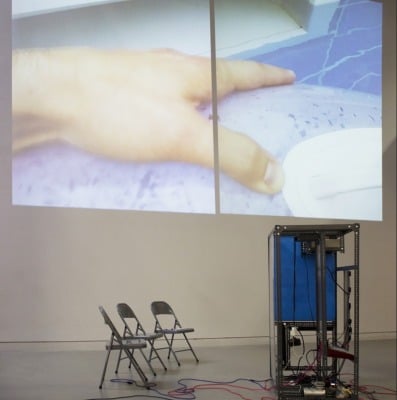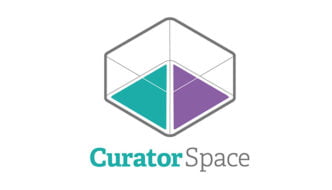Painting In Time – Interview with Sarah Kate Wilson and Zoe Sawyer
May 11, 2015
[All images courtesy of The Tetley]
Co-curated by artist Sarah Kate Wilson and The Tetley’s Curator Zoë Sawyer, ‘Painting In Time’ stems from Wilson’s ongoing research and brings together a collection of works by a cross-generational group of international artists. TSOTA writer Dan Newton chatted to Sarah and Zoe about the exhibition and the concept of painting…
TSOTA: With such a wide-ranging show housed in a specific venue, how did the curatorial process unfold?
SKW: Painting as Object was the result of a three-way discussion, so it wasn’t just that this was my main interest, but as a group this was what connected us. But then, yes, my research became more focussed on painting and its relationship with time. So this show is with people who I feel are interested in and practice similar things to me, as an artist. I run an artist collective and I’ve have worked with several of the artists before, though some are new.
ZS: Sarah and I have been in conversation for the last two years and Sarah, as well as making work and curating or co-curating various other projects, has been pursuing focussed research around painting and time, and performativity in painting.
SKW: It’s nice that the show has developed over a long period of time but with PSL (Project Space Leeds) moving to The Tetley building, it was a nice way of responding to the new space; it would have been such a different show it displayed at PSL. But the uniqueness of The Tetley, and the way it still encourages a test site-experimental approach to making – it is unique in that sense – was an interesting prospect.
ZS: And with this being such a transitional time for us, we weren’t sure how the PSL ethos would transfer to The Tetley and that we might have to adapt, so this project came to fruition during that whole period. One thing that we were able to do was invite artists to show the first painting work in the space and figure out how traditional forms of painting could be here. We have an audience here that we didn’t have at PSL. We now have a curator of participation and a steady footfall of visitors to the building, so we can guarantee the artists a live audience for every day of the exhibition. Plus we were able to commission new work, which is an important part of what we’re about, allowing artists to experiment and push their practice further for the purpose of exhibition.
SKW: Leading up to the show and with the launch of The Tetley etc, everybody knows the space really well now. People would say to us – how are you going to do a painting show with no white walls? So even within an arts community people felt it still had to be on a white wall, and we were able to begin discussing that it wasn’t that kind of painting show. It wouldn’t have had the same energy outside the spaces of The Tetley. It’s not a traditional painting show; it’s looking at how we can show painting and what painting can be in 2015 conceptually and through display. To us, looking for new developments in painting is really very normal, but for others it is strange and not traditional, so we hope to engage The Tetley’s audiences in the expanded field of painting.

Image credit: Claire Ashley ‘Another Tasteless Hunk’ (2013), photograph by Jules Lister
TSOTA: Given the eclectic variety of works on display here, what do you consider to be of particular interest in painting today?
SKW: Well for me it’s this idea that painting is in a very expanded state, and so we have painting that is connecting with sculpture, performance, dance and drawing. What I am very interested in are those things involved within the medium of painting where this idea of time can come in. So I am interested in paintings that continue to evolve once they leave the studio. That’s a major interest in my work, and the artists I look to and the writers and theories that I look at too. For me it’s painting that destabilises the idea of the static object and instead embraces a continuation of change. And that can be through the use of materials that change like things that might set on fire or decay, but also through the audience changing things.
So with Kate Hawkins you’ve got the audience being able to move hinged paintings on the wall and make different positions, and then you’ve got machines that make paintings, like with Natasha Kidd’s work, the machine is making the work, but then the gallery attendants are having to interact with it too. I am interested in artists putting the work out of the studio and saying this will continue to evolve – this will only last for a certain amount of time – so with [Polly] Apfelbaum’s pieces, they only exist for us, because at the end of the show they’re going to be destroyed.
ZS: Painting has that innate relation to the market and value and preciousness, and I think that anything which destabilises people’s preconceptions about what a certain art form should be is always interesting and exciting. I think we are living in a point in art history where there is a lot of crossover and hybridity; not only has painting expanded in its field but so have sculpture and performance; there are many crossovers between disciplines. But I guess painting has often been tied to the canvas, whilst still being relatively free conceptually. It was interesting making the exhibition, for not all of the artists are perceived by the art world as ‘painters’ or connected to painting. For example Kristina Buch doesn’t simply identify herself as a painter. So for me artists that operate between different disciplines with a constantly evolving practice are an interesting prospect.

Image credit: Natasha Kidd ‘Overfill’ (2015) photograph by Jules Lister
TSOTA: Since the beginning of modernism, we have been seeking to expand the capacity of art. Now that we find ourselves in a state where seemingly ‘anything goes’, some thinkers and practitioners appear to be working in reverse – almost refining the parameters of what art isn’t. What would it take for the works on display here to not be paintings?
SKW: I think when you go down the route of what is and what isn’t, you get into these dialectical oppositions and it’s not very useful to talk about painting in these terms. I think it’s more interesting to talk about things in terms of species and new breeds So instead art is a way of thinking of ideas on what is possible now in post modernism. I guess post modernism is more interested in ‘anything goes’, DJing and mixing different things together. Whereas, I think, you’re right, there does seem to be a return to people wanting ‘boundaries’ back in place again, but for me it’s more that you can accept and have both ideas held in your mind at the same time rather than simply saying no or yes.
ZS: Yeah I think things can fit into both camps, and coexist or have simultaneous identities. Someone can be both a painter and a sculptor or have two practices that sit in both camps. And because of art history, there might be a whole mass of theory that connects to one and not to another, but you can’t really escape from this.
SKW: Is there anything, Dan, that you think can’t be painting?
TSOTA: Well I think in many ways I agree with that room for coexistence. But I think that certainly from my experience as a gallery invigilator, many visitors, particularly perhaps of an older generation are very much interested in this sense of distinction and borders – why is this a painting and not a sculpture, how can it be both, is painting simply a mentality here? I think, going back to the Jerwood Drawing Prize, an audio work claiming the prize is a good example of that hybridity or new breed that you talk about. And this is absolutely of interest to artists. But I do feel that for many people, there is that urge for a sense-grounding and coming back to some form of reality.

Image credit: Jessica Warboys, ‘Box Painting (3)’ photograph by Jules Lister
SKW: I think that just by me using the word ‘painting’, when I talk about my own practice, I’m attaching myself to that history and that lineage of painting, but it’s not just a lineage that’s like: this happened then that happened etc, and now in 2015 this is happening. It’s more rhizomatic really, like things are popping up over here and making connections in the ‘60s and those things in the ‘60s are making connections with what’s going to happen in 2025. So it’s more like bouncing back and forth and things developing in different directions, rather than a straight line of art history. This is why time is really interesting to me, because time can be both cyclical and linear; we can go back and forward in time.
The internet and other developments are mixing times up constantly in our minds.
ZS: This is probably why it’s quite helpful for people to want to return to a pure form or discipline, because then it will get disrupted again and something else will happen. I think I’ve heard tutors talking about this in universities. Some of the more expansive courses like contemporary art practice are almost fading out, and then some, rather than being multidisciplinary, have actually reinstated the discipline; like fine art painting, sculpture, drawing etc, such as on the Leeds College of Art foundation course now. I don’t know how that will affect practice, but it’s a case of expanding and contracting certain boundaries to give people something to rub up against and a reason to push their practice again and push boundaries rather than them being ever-expanding. Maybe it’s something that’s needed as a catalyst.

Image credit: Sarah Kate Wilson ‘Zumba'(2015) photograph by Jules Lister
TSOTA: So do you think that in many ways we are outgrowing these terms? Are they now a state of mind, a theoretical perspective, even a hindrance, or are they, as we’ve just touched upon, necessary anchors?
SKW: I think they’re really useful terms to tether to us to history. So I’m very interested in playing with that history and seeing what we can create as new history rather that coming up with a new term or being in no man’s land. It’s useful for me anyway, it might not be for everybody! I find it useful because there is a point of departure and return , and going back and forth between those two is where I like to put my thinking. So that’s what’s exciting for me. But also, as you’ll see from the show, there is the removal of the artist’s hand and letting machines do things, but these machines are also being a little bit tricky at the same time – they need people to help with them when the artists aren’t there. So it’s not simply a show where we went to artists’ studios and picked up pieces. It’s been interesting because all of the artists in the exhibition are alive and working today, and we were able to speak to, meet and work alongside them, so the show is unique in that sense. It’s been a really involved experience, which is why it’s taken so long. It’s easy to simply loan works but that doesn’t fit with The Tetley’s ethos or mine, and it’s been exciting bringing something like this to Leeds.

Image credit: Sarah Kate Wilson, ‘Zumba'(2015)
TSOTA: Do you think that Painting in Time could become not only a touring exhibition but a serial show or project, with the same dialogue and test-site platforms, but in conversation with new artists?
ZS: There is definitely interest in doing this.
SKW: Yeah. Sorry to use the word but things take time. If you’re going to ask people to produce site-specific works, then everyone has different schedules and travels all over the world, and people have children and different things going on. Because we’ve had such good lead-in time, partly because the building wasn’t ready when we first started talking about it and with these international artists, it was always going to be difficult installing the exhibition in a certain amount of time. But we had two weeks to install, which is quite rare really, often you only get a week or so. Zoe and I pretty much camped out and were there for the whole thing. And artists could work there. So I think it would be really great to take this to other venues, and people would perhaps show different works, or other artists would join in. Regarding The Tetley, Zoe and I were always keen for the show to evolve during its three months there. You might have seen, Claire Ashley has paintings on the roof flags – they’ve only been there for two and a half weeks.
ZS: They’ve had a bit of a bashing this weekend with the rain. They have deteriorated quite a lot, which is sort of in keeping with the exhibition even though it wasn’t exactly the intention – even though we knew they were going to be exposed to the weather it has happened much quicker than anticipated. So Claire is going to make some additional flags that we can swap in and out when necessary, and then we may find a way of exhibiting the flags that have been exposed to the elements within the exhibition. There’s also the prospect that other artists might add bits in later on in the show. With it being three months, artists are developing work, and the project has instigated a certain trajectory in their work, so if work becomes realised during the exhibition it might be added in.
SKW: And I think that’s the way Zoe programmes exhibitions as well, it’s always very pro-artist thinking, and it’s led by a more experimental nature rather than something set or fixed. As you’ll see with the flags, they’ve changed a lot, but then you’ve also got her inflatable works in the atrium space; every time you see them they have either inflated or deflated, so things are always altering. With the machines making Natasha [Kidd]’s works, more paint is added to the floor all the time. My works are performed at set times throughout the day and the times change. There’s always this idea that everything is always in motion, which is not usual for painting I guess.

Image credit: Yoko Ono ‘Painting to Hammer a Nail’ (1961), photograph by Jules Lister
TSOTA: Is there any direction in which you would like to see painting expand in the future, any particular routes, or is it just impossible to measure?
SKW: I would like to see painting [as discussed above] collected by museums. As you know they have collections for painting, sculpture, drawing, photography and time-based media, but within time-based media collections, there isn’t any painting acknowledged. But artists are working in a way in which painting does need to be acknowledged as time-based, because it has things like computer technology attached for making paintings, or it has materials that need conserving in a different way to how an oil painting needs conserving. So I am keen to start talking to museums more about that, as part of my research as well.
ZS: Even just reframing their collections, so things that have been collected as new media or performance might actually require re-curating in a sense. I mean you could have ten other exhibitions that could potentially be re-curated around re-curating existing collections, where maybe works have been collected under a different banner.
SKW: That’s what I would like! That’s one of the next steps for me, to start talking to museums about this. It’s something I’m really interested in, and I’m sure museums are. It’s not such a new move for paintings to be accepted as time-based, but it is something that needs to be more acknowledged. Maybe it’s a big ask, but I don’t think it is!
ZS: The prospect of this show touring and moving beyond The Tetley is something that we haven’t quite had the chance to properly look at yet. In the past there has been an aspiration to do so but we haven’t been in a position to support it, but I think it would be great for this work to tour, and I imagine that it would change dramatically depending on the venue it travels to. Not everyone will be able to come and see it whilst it’s at The Tetley, but if the exhibition or a different iteration of it could move around the country or beyond, that would be great.
SKW: Exactly, it’s about how it can evolve, and a natural way of doing this is to move to another space or location, not necessarily a gallery space, and this is something we hope to look at!
For more information about the Painting In Time Exhibition please see: Painting In Time
Dan Newton
Filed under: Art & Photography
Tagged with: curator, interview, painting, Painting In Time, The Tetley



Comments